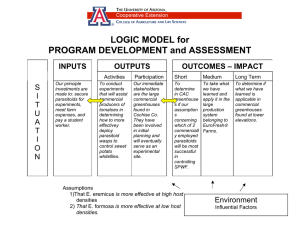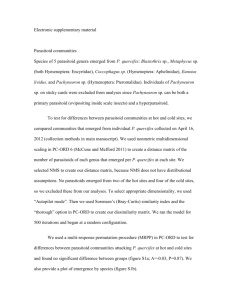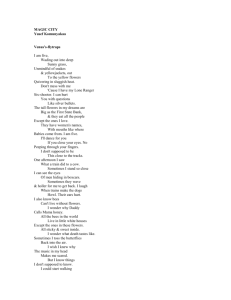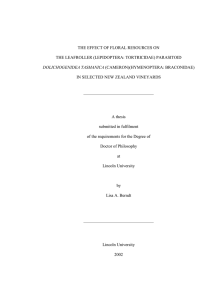ADDING FLORAL DIVERSITY TO ENHANCE PARASITOID FITNESS AND EFFICACY S. Wratten, L. Berndt,
advertisement
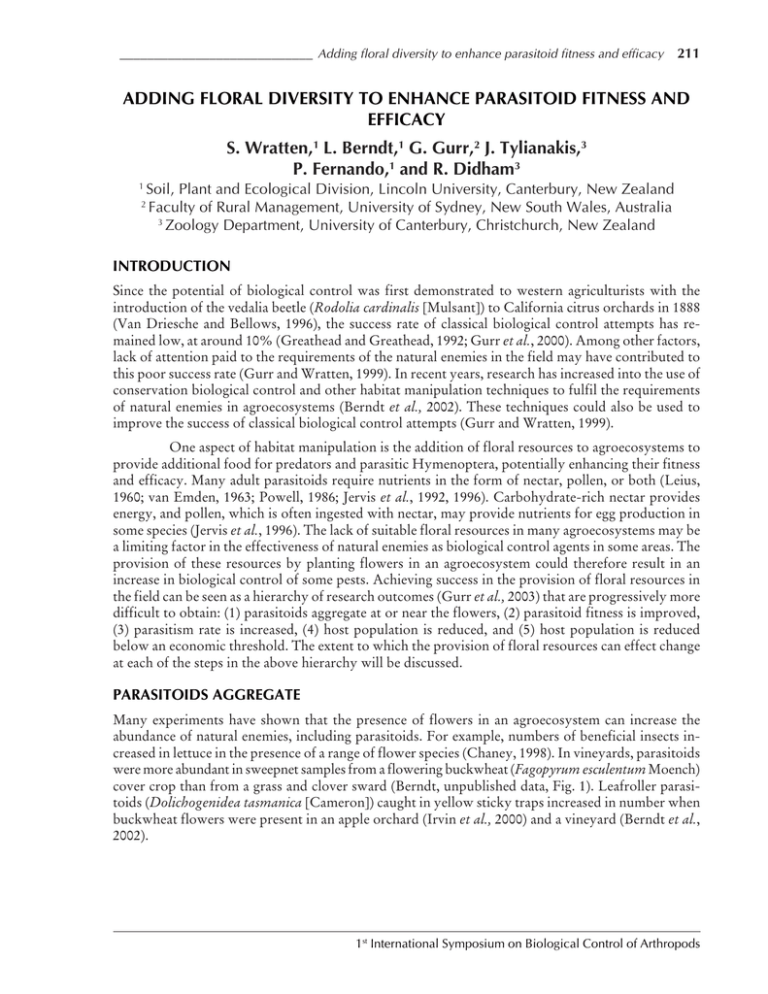
____________________________ Adding floral diversity to enhance parasitoid fitness and efficacy 211 ADDING FLORAL DIVERSITY TO ENHANCE PARASITOID FITNESS AND EFFICACY S. Wratten,1 L. Berndt,1 G. Gurr,2 J. Tylianakis,3 P. Fernando,1 and R. Didham3 1 2 Soil, Plant and Ecological Division, Lincoln University, Canterbury, New Zealand Faculty of Rural Management, University of Sydney, New South Wales, Australia 3 Zoology Department, University of Canterbury, Christchurch, New Zealand INTRODUCTION Since the potential of biological control was first demonstrated to western agriculturists with the introduction of the vedalia beetle (Rodolia cardinalis [Mulsant]) to California citrus orchards in 1888 (Van Driesche and Bellows, 1996), the success rate of classical biological control attempts has remained low, at around 10% (Greathead and Greathead, 1992; Gurr et al., 2000). Among other factors, lack of attention paid to the requirements of the natural enemies in the field may have contributed to this poor success rate (Gurr and Wratten, 1999). In recent years, research has increased into the use of conservation biological control and other habitat manipulation techniques to fulfil the requirements of natural enemies in agroecosystems (Berndt et al., 2002). These techniques could also be used to improve the success of classical biological control attempts (Gurr and Wratten, 1999). One aspect of habitat manipulation is the addition of floral resources to agroecosystems to provide additional food for predators and parasitic Hymenoptera, potentially enhancing their fitness and efficacy. Many adult parasitoids require nutrients in the form of nectar, pollen, or both (Leius, 1960; van Emden, 1963; Powell, 1986; Jervis et al., 1992, 1996). Carbohydrate-rich nectar provides energy, and pollen, which is often ingested with nectar, may provide nutrients for egg production in some species (Jervis et al., 1996). The lack of suitable floral resources in many agroecosystems may be a limiting factor in the effectiveness of natural enemies as biological control agents in some areas. The provision of these resources by planting flowers in an agroecosystem could therefore result in an increase in biological control of some pests. Achieving success in the provision of floral resources in the field can be seen as a hierarchy of research outcomes (Gurr et al., 2003) that are progressively more difficult to obtain: (1) parasitoids aggregate at or near the flowers, (2) parasitoid fitness is improved, (3) parasitism rate is increased, (4) host population is reduced, and (5) host population is reduced below an economic threshold. The extent to which the provision of floral resources can effect change at each of the steps in the above hierarchy will be discussed. PARASITOIDS AGGREGATE Many experiments have shown that the presence of flowers in an agroecosystem can increase the abundance of natural enemies, including parasitoids. For example, numbers of beneficial insects increased in lettuce in the presence of a range of flower species (Chaney, 1998). In vineyards, parasitoids were more abundant in sweepnet samples from a flowering buckwheat (Fagopyrum esculentum Moench) cover crop than from a grass and clover sward (Berndt, unpublished data, Fig. 1). Leafroller parasitoids (Dolichogenidea tasmanica [Cameron]) caught in yellow sticky traps increased in number when buckwheat flowers were present in an apple orchard (Irvin et al., 2000) and a vineyard (Berndt et al., 2002). 1st International Symposium on Biological Control of Arthropods 212 Wratten et al. ___________________________________________________________________________ Parasitoid wasps per sweep sample 20 15 10 5 0 Buckwheat Control Figure 1. Mean number of parasitoid wasps (Hymenoptera) per sweepnet sample in flowering buckwheat and in control vegetation (grass and clover sward) between vine rows in a vineyard. Error bars = two standard errors. FITNESS IMPROVED The presence of flowers in an agroecosystem may increase parasitoid efficacy by improving their fitness. In the field this may be observed as a long-term increase in abundance, or as an increase in parasitism rate. In the laboratory, aspects of parasitoid fitness, such as longevity, fecundity, and offspring sex ratio are influenced by the presence of floral resources. The longevity of Trichogramma carverae Oatman and Pinto doubled when these parasitoids were provided with honey (Gurr and Nicol, 2000). The longevity of D. tasmanica was more than six times greater when these parasitoids had access to alyssum flowers (Lobularia maritima L.) than when they were fed water only (Berndt and Wratten, 2001). Fecundity also increases when food is available. The potential fecundity (egg load) of Diaeretiella rapae (Mc Intosh) was greater when parasitoids were given sugar than when they were given pollen or no food (Tylianakis, unpublished data). The realized fecundity (number of eggs laid) of Goniozus jacintae Farrugia increased threefold when buckwheat flowers were provided, compared with water alone (Fernando, unpublished data). The number of F1 cocoons (another measure of realised fecundity) produced over a lifetime by D. tasmanica was more than seven times greater for parasitoids with access to alyssum flowers than for those fed water only (Berndt, unpublished data). The sex ratio of parasitoid offspring can also affect fitness. D. tasmanica produced a greater proportion of female offspring when flowers were available, than when no flowers were present, in both field (Berndt et al., 2002) and laboratory (Berndt, unpublished data) experiments. PARASITISM RATE INCREASED The third level in the hierarchy of measures of success is to demonstrate an increase in biological control of a pest in the presence of flowers. For example, coriander (Coriandrum sativum L.) and faba bean (Vicia faba L.) planted next to potato plots increased the parasitism rate of the potato moth (Phthorimaea operculella [Zeller]) by Copidosoma koehleri Blanchard (Baggen and Gurr, 1998). Irvin et al., (2000) also reported a significantly greater parasitism rate of leafrollers (Epiphyas postvittana [Walker]) in an apple orchard with buckwheat and faba bean, compared with that found in control plots. 1st International Symposium on Biological Control of Arthropods ____________________________ Adding floral diversity to enhance parasitoid fitness and efficacy 213 HOST POPULATION REDUCED Pest populations have been reduced in some studies by the provision of flowers in an agroecosystem. Patt et al. (1997) achieved this fourth level of the hierarchy when they found that dill (Anethum graveolens L.) in eggplant (Solanum melongena L.) fields reduced the survivorship of Colorado potato beetle (Leptinotarsa decemlineata [Say]) larvae. Another study found fewer aphids in cabbage plots with a border of phacelia (Phacelia tanacetifolia Bentham) than in those without (White et al., 1995). However, the natural enemies discussed in both of these studies were predators, not parasitoids. HOST POPULATION BELOW ECONOMIC THRESHOLD The fifth level of the hierarchy, to reduce the pest below an economic threshold, is the most difficult to demonstrate. Very few, if any, studies dealing with the provision of flowers to enhance parasitoid efficacy have achieved it, and there appear to be no published examples. This lack of evidence for this fifth level of success may be because this technique is most useful in conjunction with other biological control or integrated pest management methods. Flowers may be added to an agroecosystem to enhance the effectiveness of classically or augmentatively released natural enemies (Gurr and Wratten, 1999), or their use can be incorporated with the use of selective (Ruberson et al., 1998), or reduced rate insecticides (van Emden, 1988; Poehling, 1989). Most research to date on the provision of floral resources has focused on this technique in isolation, in part to establish the mechanisms of action of the method. Future workers aiming to develop commercially viable biological control strategies may benefit by drawing on all relevant branches of biological control and integrated pest management. REFERENCES Baggen, L. R. and G. M. Gurr. 1998. The influence of food on Copidosoma koehleri (Hymenoptera: Encyrtidae), and the use of flowering plants as a habitat management tool to enhance biological control of potato moth, Phthorimaea operculella (Lepidoptera: Gelechiidae). Biological Control 11: 9-17. Berndt, L. A. and S. D. Wratten. 2001. Biodiversity in the vineyard-worth the bother? Winepress 101: 27-30. Berndt, L. A., S. D. Wratten, and P. Hassan. 2002. Effects of buckwheat flowers on leafroller (Lepidoptera: Tortricidae) parasitoids in a New Zealand vineyard. Agricultural and Forest Entomology 4: 39-45. Chaney, W. E. 1998. Biological control of aphids in lettuce using in-field insectaries, pp. 73-83. In Pickett, C. H. and R. L. Bugg (eds). Enhancing Biological Control: Habitat Management to Promote Natural Enemies of Agricultural Pests. University of California Press, Berkeley, California, U.S.A. Greathead, D. and A. Greathead. 1992. Biological control of insect pests by insect parasitoids and predators: the BIOCAT database. Biocontrol News and Information 13: 61-68. Gurr, G. M. and H. I. Nicol. 2000. Effect of food on longevity of adults of Trichogramma carverae Oatman and Pinto and Trichogramma nr brassicae Bezdenko (Hymenoptera: Trichogrammatidae). Australian Journal of Entomology 39: 185-187. Gurr, G. M. and S. D. Wratten. 1999. “Integrated biological control”: a proposal for enhancing success in biological control. International Journal of Pest Management 45(2): 81-84. Gurr, G. M., N. D. Barlow, J. Memmott, S. D. Wratten, and D. J. Greathead. 2000. A history of methodological, theoretical and empirical approaches to biological control, pp. 3-37. In Gurr, G. M. and S. D. Wratten (eds). Biological Control: Measures of Success. Kluwer Academic Publishers, Dordrecht, The Netherlands. 1st International Symposium on Biological Control of Arthropods 214 Wratten et al. ___________________________________________________________________________ Gurr, G. M., S. D. Wratten, and J. M. Luna. 2003. Multi-function agricultural biodiversity: pest management and other benefits. Basic and Applied Ecology (in press). Irvin, N. A., S. D. Wratten, and C. M. Frampton. 2000. Understory management for the enhancement of the leafroller parasitoid Dolichogenidea tasmanica (Cameron) in orchards at Canterbury, New Zealand, pp. 396-403. In Austin, A. D. and M. Dowton (eds). Hymenoptera: Evolution, Biodiversity and Biological Control. CSIRO Publishing, Collingwood, Victoria, Australia. Jervis, M. A., N. A. C. Kidd, and M. Walton. 1992. A review of methods for determining dietary range in adult parasitoids. Entomophaga 37: 565-574. Jervis, M. A., N. A. C. Kidd, and G. E. Heimpel. 1996. Parasitoid adult feeding behaviour and biocontrol—a review. Biocontrol News and Information 17(1): 11N-26N. Leius, K. 1960. Attractiveness of different foods and flowers to the adults of some hymenopterous parasites. The Canadian Entomologist 92: 369-376. Patt, J. M., G. C. Hamilton, and J. H. Lashomb. 1997. Impact of strip-insectary intercropping with flowers on conservation biological control of the Colorado potato beetle. Advances in Horticultural Science 11: 175-181. Poehling, H. M. 1989. Selective practices for insecticides and agricultural crops pp. 151-175. In P. Jepson (ed.) Effects of Pesticides on Non-target Invertebrates. Intercept, Wimborne, U.K. Powell, W. 1986. Enhancing parasitoid activity in crops, pp. 319-340. In Waage, J. and D. Greathead (eds). Insect Parasitoids. Academic Press, London. Ruberson, J. R., H. Nemoto, and Y. Hirose. 1998. Pesticides and conservation of natural enemies in pest management, pp. 207-220. In Barbosa, P. (ed.). Conservation Biological Control. Academic Press, San Diego, California, U.S.A. Van Driesche, R. G. and T. S. Bellows, Jr. 1996. Biological Control. Chapman and Hall, New York. van Emden, H. F. 1963. Observations of the effects of flowers on the activity of parasitic Hymenoptera. Entomologist’s Monthly Magazine 98: 265-270. van Emden, H. F. 1988. The potential for managing indigenous natural enemies of aphids on field crops. Philisophical Transactions of the Royal Society of London (B) 318: 183-201. White, A. J., S. D. Wratten, N. A. Berry, and U. Weigmann. 1995. Habitat manipulation to enhance biological control of brassica pests by hover flies (Diptera: Syrphidae). Journal of Economic Entomology 88: 1171-1176. 1st International Symposium on Biological Control of Arthropods
